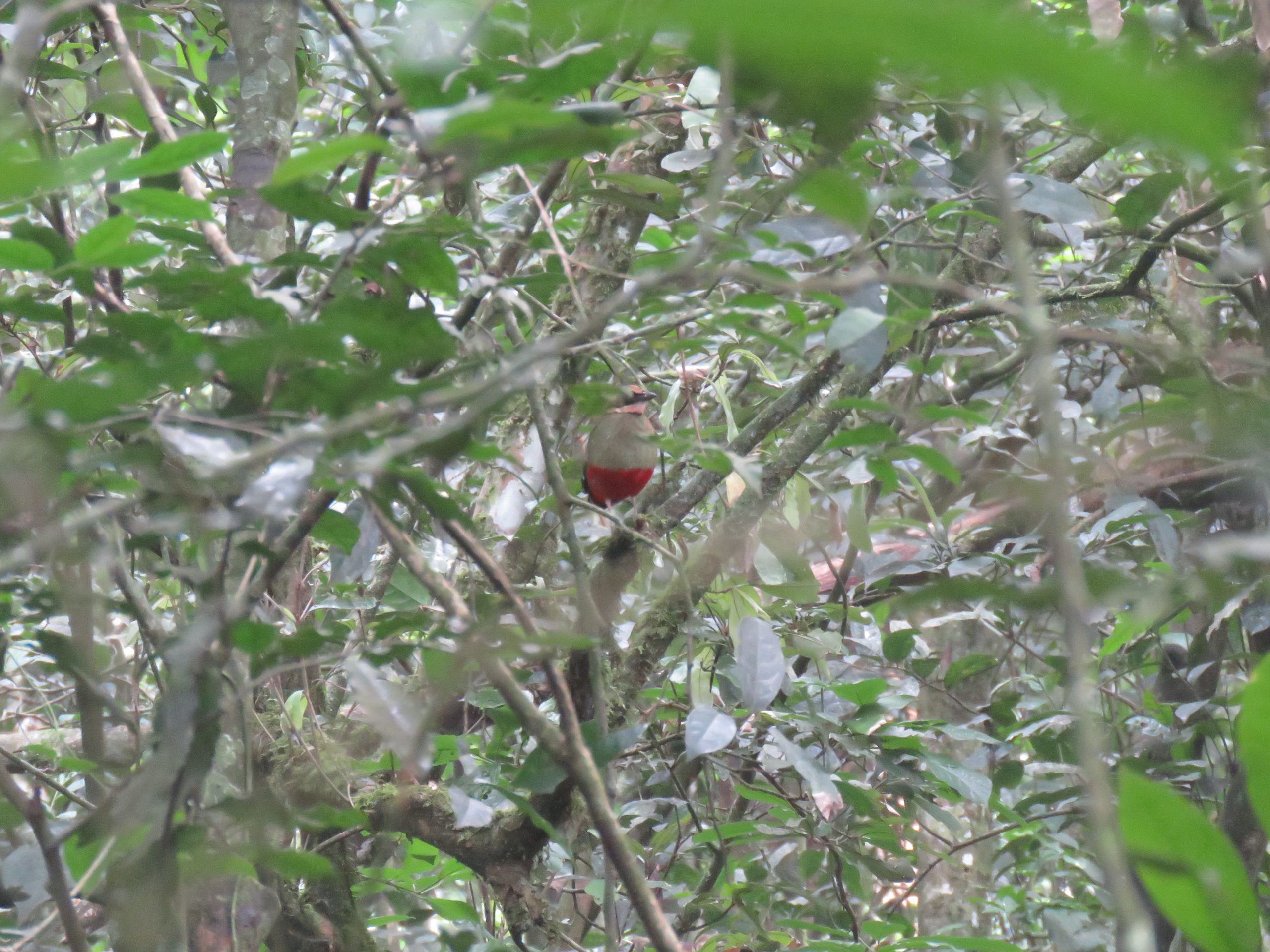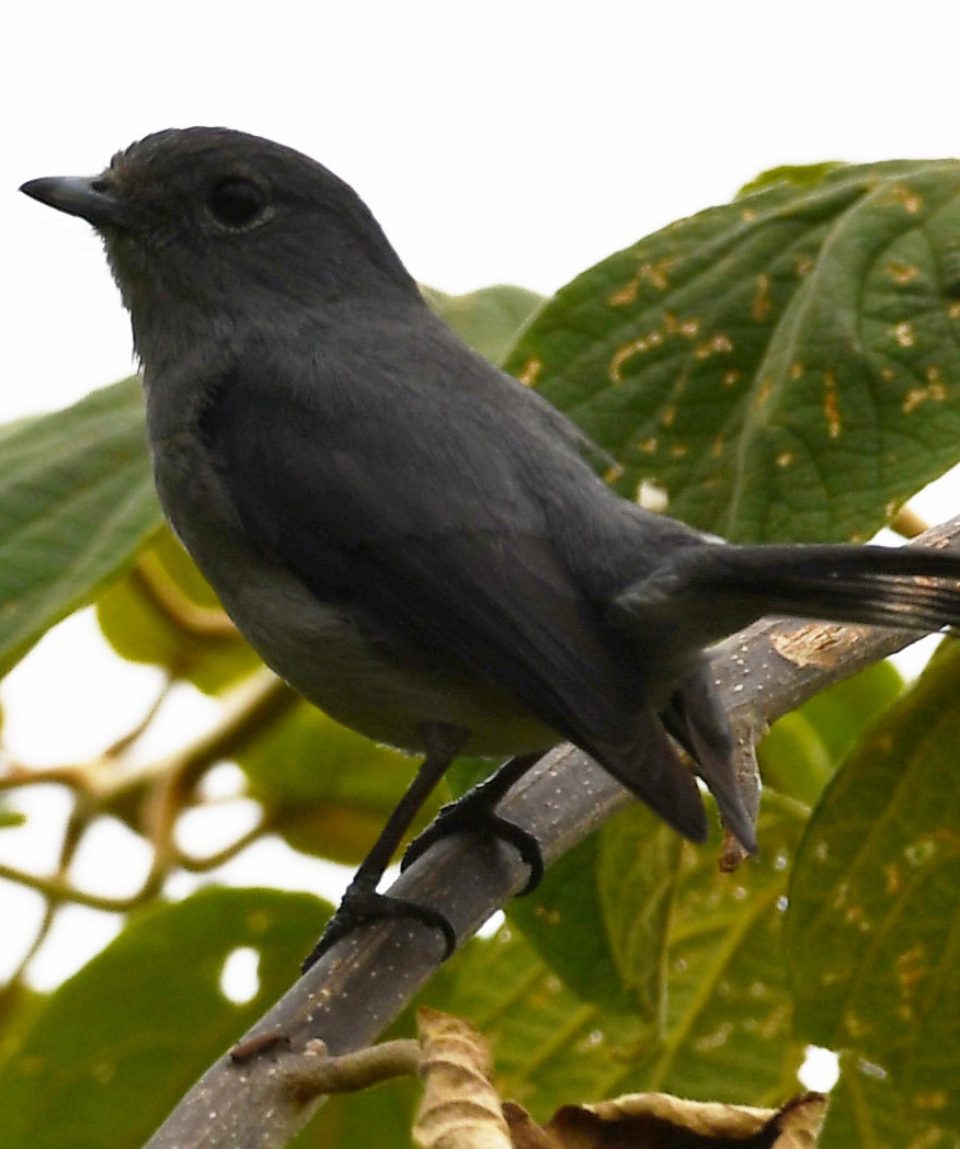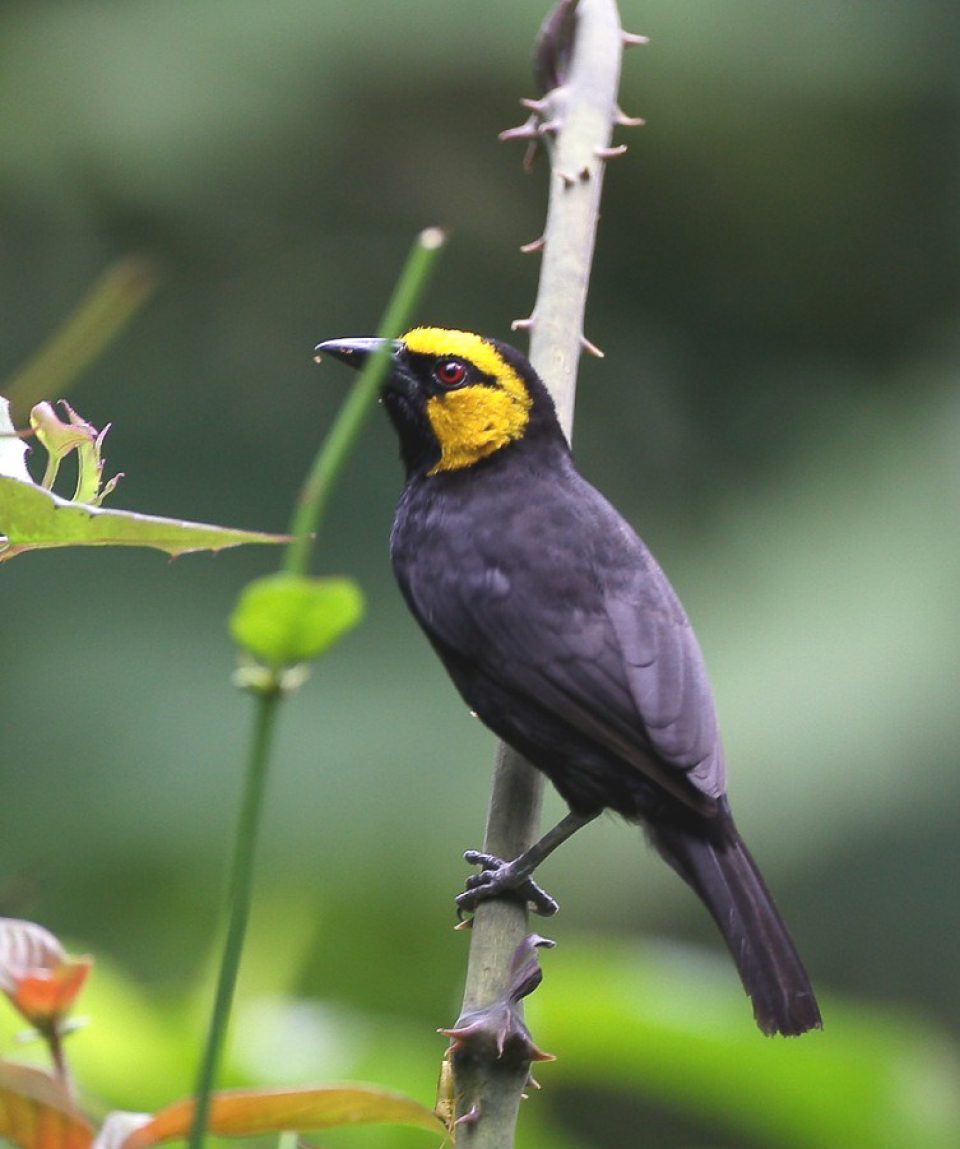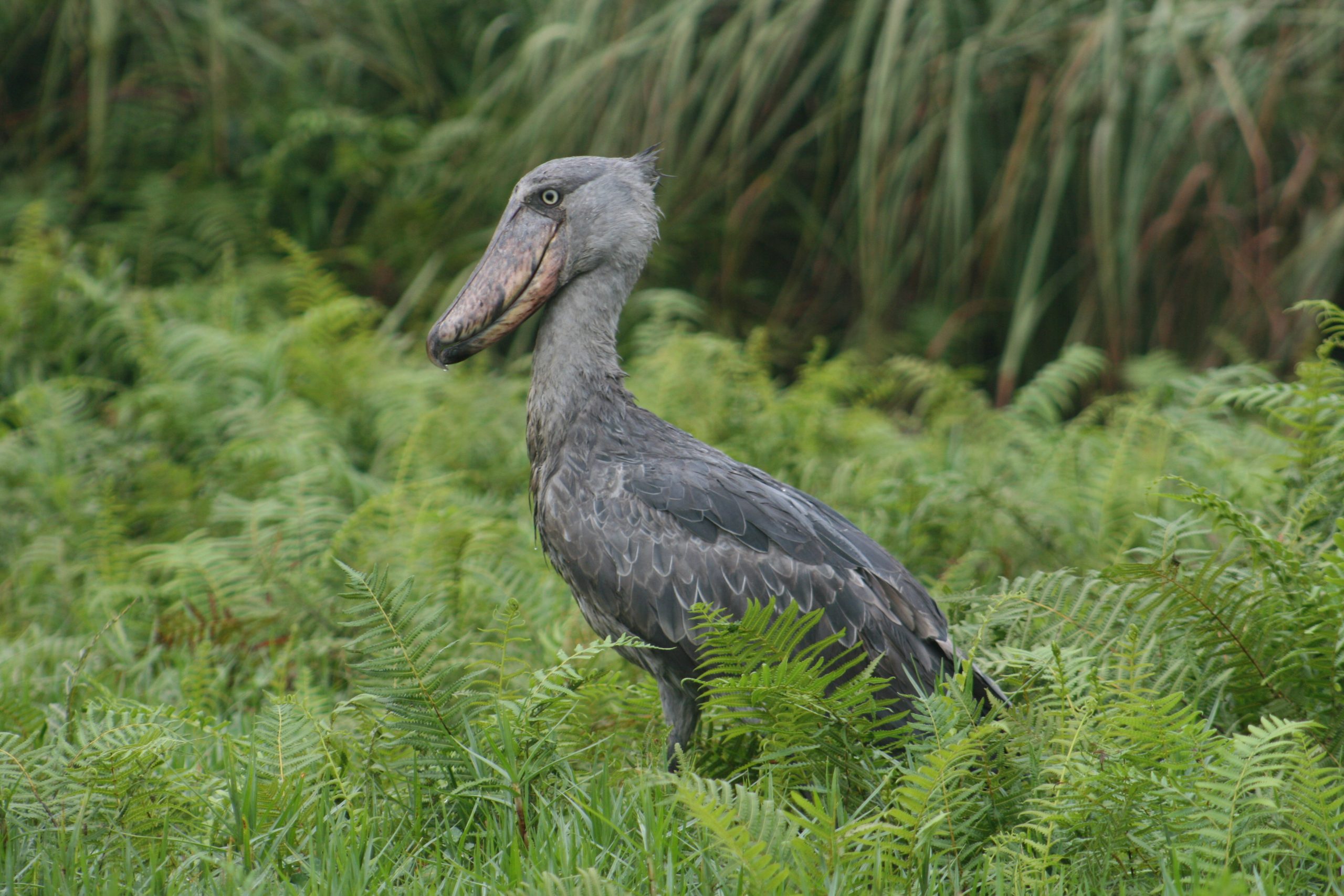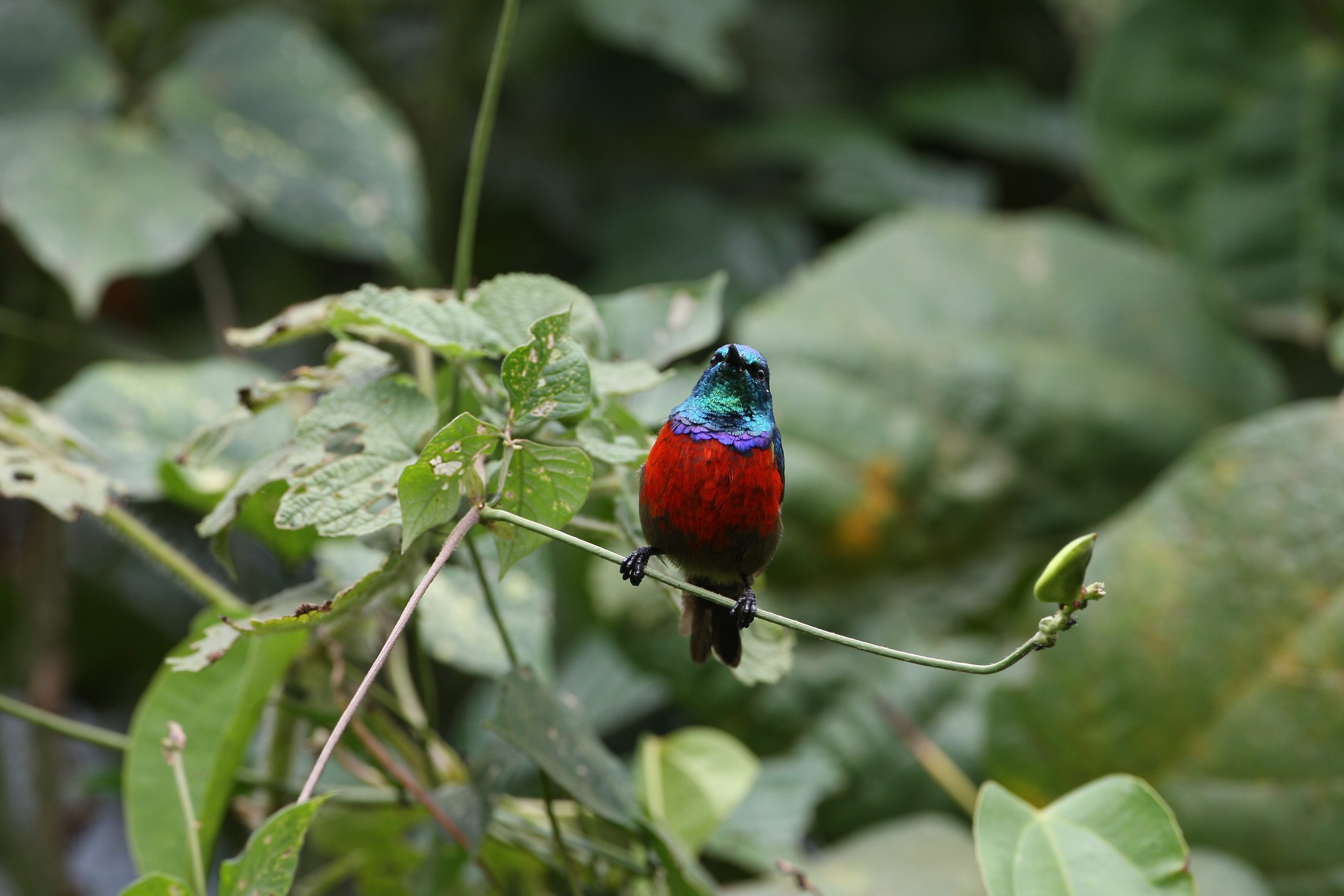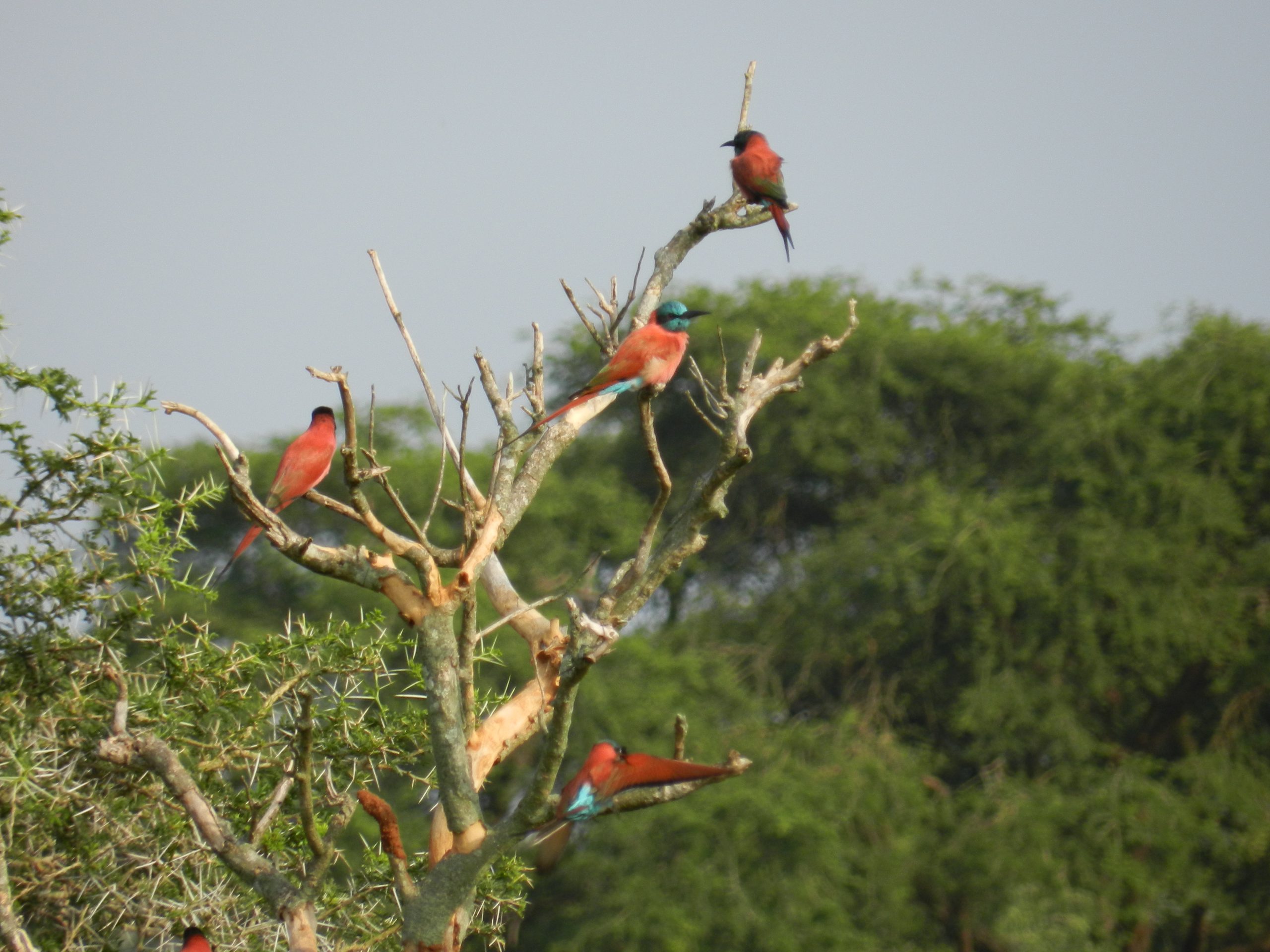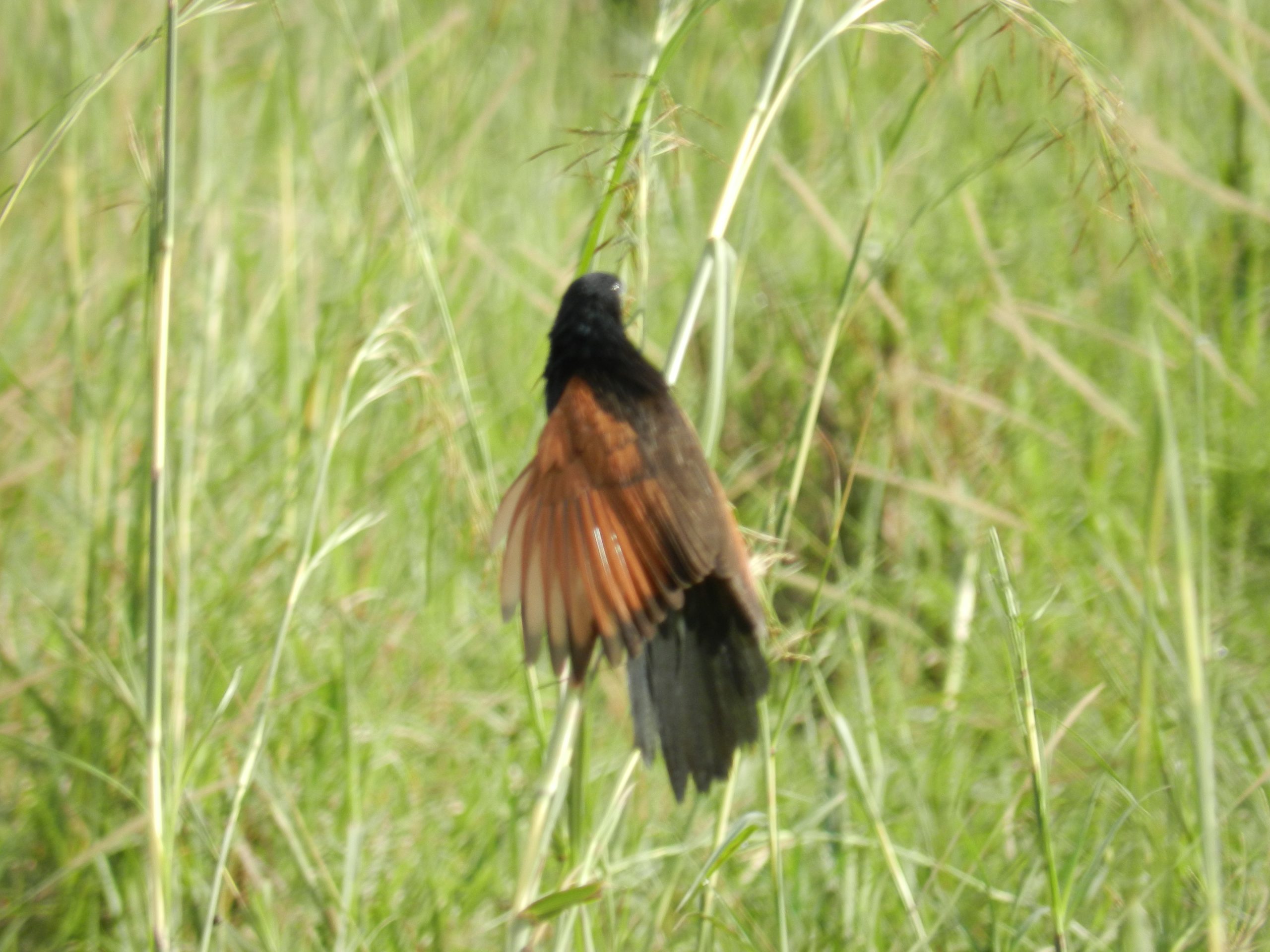23 Days Extreme Birding and Wildlife Experience Safari
from
ITINERARY- DAY BY DAY
Day One:
Arrival (Meeting day)
Upon arrival you will be met by one of our professional bird guides and transferred to your hotel of choice. Depending on the time of arrival, we may start our safari with bird watching around the shores of Lake Victoria in Entebbe.
Day Two:
Bird watching to Mabamba Swamp and afternoon transfer to Mburo. (2 nights at Lake Mburo)
This day we shall visit the Mabamba Village and its adjacent swamp on our birding safari in Uganda, a labyrinth of channels and lagoons located about 52 km from Kampala. The road to Mabamba winds its way through areas of secondary forest and agricultural land attracting Red-headed Lovebird, African Crowned-Hornbills, and a range of sunbirds including the Green-headed, Green, Red-chested, Collared, Marico and Scarlet-chested. We shall stop over at Mpigi Swamp to look out for the Papyrus Gonolek and the White-winged Warbler. The road ultimately ends at a papyrus reedbed adjoining Lake Victoria, where we will explore by canoe a maze of channels and mudflats for a reliable resident, the majestic Shoebill. Although sightings can never be guaranteed, we should have a very good chance of seeing this magnificent bird in Mabamba.
The Mabamba swamp also offers a large selection of other bird species which might include African Pygmy Goose, the rare Lesser Jacana, Carruthers’ Cisticola, African Fish Eagle, Winding Cisticola, Fan-tailed Widowbird, Blue-breasted Bee-eater, etc. The rare and elusive Sitatunga Antelope also occurs here but it is very shy and rarely seen. We also expect to encounter the Spot-necked Otter in one of the channels that we shall paddle through.Proceed to Lake Mburo National Park.
High Chances of the conspicuous birds encountered whilst driving towards the park include, Red faced Barbet, Tabora Cisticola, Green backed wood pecker,Crested Francolin, Emerald spotted wood Dove, Brown Parrot, Barefaced Go-away -bird. Blue-napped Mousebird, Lilac-breasted Roller, and Green Wood-hoopoe, common Scimitarbill, African Grey Hornbill, Spot-flanked Barbet, Nubian Woodpecker, Trilling Cisticola, Yellow-Breasted Apalis, Northern Black Flycatcher, Chin-spot Batis, Greater Blue-eared starling and Marico sunbird.
Day Three:
Game drive and Boat cruise in the Park
Birding whilst on a game drive in the park and a boat ride on Lake Mburo will increase our chances to see animals like buffalos, water and bush bucks, zebras, leopard, mongoose, Topi, warthogs and Impalas. Birds include African Finfoot, a very shy bird, white-backed night heron, Giant Kingfisher, Black Collard Barbet, Malachite Kingfisher, as well as animals like crocodiles and hippos.
The more open grassland north of the camp, particularly along the Zebra Track, is worth exploring for species such as Coqui Francolin, Red-necked Spur fowl, Black-bellied Bustard, Temminck’s Courser, African Wattled Plover, Rufous-Naped and lapped Larks, Rufous-chested Swallow, Yellow-throated Longclaw and Southern Red Bishop. Small number of the migratory Brown-chested Plover is regularly observed. Check the grassland around the Mirllti Valley trail. Some of the nocturnal species include African Scops Owl; Verreaux’s Eagle-Owl and Fiery-necked, Pennant-winged, Swamp, and Black shouldered Nightjars.
Day Four to Nine:
Birding to Bwindi (Ruhija and Buhoma) and the Gorilla Trekking with other primates.
Bwindi Impenetrable Conservation Area lies in the rugged Kigezi highlands of South Western Uganda, protecting a continuum of forest that ranges from montane to low land areas. It is this altitudinal variation, combined with its location within the Albertine Rift that results in Bwindi impenetrable being the richest forest in East Africa in terms of its trees, butterflies and birds. Bwindi is a home over half of the remaining Mountain Gorillas populations in the World.
Bwindi is a bird watchers’ haven; it holds 400 species of birds. The forest has 10 of the 26 globally threatened species in Uganda, five of which are vulnerable. Bwindi has recorded 24 of the locally Albertine Rift endemic species in the country and some, such as African Green Broadbill, Chapin’s Flycatcher and Shelley’s Crimson-wing , Purple Breasted Sunbird and others.
Bwindi national park has 76 of 144 Guinea – Congo Forest biome species that occur in Uganda, recorded especially in the North sector. The site also qualifies for Afro tropical highland biome species with 68 of 86, and for the Lake Victoria biome with 4 of 12 species. The park is blessed with 90% of all albertine rift endemics, difficult or impossible to see in any other part of East Africa and seven IUCN red data listed species. An experienced birder watcher can identify over 150 species in a day.
Ruhiija is likely to be one of the highlights of any bird watching safari to Uganda with excellent birding in spectacular surroundings. The Birds are many here and somehow easy to see; many bird species associating in mixed feeding flocks that are active throughout the day. An early start offers the best chance of finding the striking Handsome Francolin, Cinnamon-chested bee-eater, western Green Tinkerbird, Mountain and yellow-streaked Greenbuls, Regal Sunbird, Black headed waxibill, Grauer’s warbler, Dusky Crimsonwing, White starred robin, Rwenzori Night jar, Mountain marked and chestnut-throated Apalises, Rwenzori batis, white-tailed crested Flycatcher and many more.
Day Nine to Ten:
Bird watching to Queen Elizabeth National Park
After an early morning breakfast, we begin the long drive to the renowned Queen Elizabeth National Park, frequently stopping for birding along the way. Going through the Ishasha sector of Queen Elizabeth will give us a chance of seeing the Tree-climbing lions.
Spanning the equator is the vast Queen Elizabeth National Park boasting impressive Crater Lake scenery, expansive grasslands, papyrus swamps and tropical forests, huge herds of Elephant and Buffalo, Lions, Leopards, and a diverse array of birds. It contains Uganda’s best game populations as well as some of Uganda’s best bird watching sites, an incredible bird list of 610 bird species and an overwhelming record of 298 species in a single day, makes this birding site the highest not only in Uganda but in Africa!
Depending on time of arrival, some late afternoon birding might produce views of the African Morning Dove, Grey-headed Kingfisher, Black-headed Gonolek, Slender-billed, Yellow-backed and Lesser-masked Weavers, Pin-tailed Whydah and Black-winged Pratincole. The following day, we have an early start of bird watching in Uganda and a game drive in the park towards the Kasenyi trail. The game drive takes us through a productive area of grassy plains, which support large flocks of a variety of stork species including the Spectacular Saddle-billed and Woolly necked Storks. Other species include the Bateleur, Grey Kestrel, Lappet-faced, Ruppell’s Griffon, White-backed and Palm-nut Vultures, African Crake, Black Coucal, Common Button, Harlequin and Black-rumped Quails, Red-necked Spurfowl, Rufous-naped and Flappet Larks. Common mammals include Uganda Kob, Lion, Warthog, Bush Buck, Deffassa Waterbuck, Spotted Hyena, Leopard and many others.
In the afternoon we take a launch tour of the Kazinga Channel which is a natural magnet for herds of Elephant, Giant Forest Hog, Buffalo, Monitor lizard, Crocodiles and the abundant Hippopotamus. Birding here is excellent with great photographic opportunities. We might be blessed with congregations of African Skimmers, Great-white and Pink-backed Pelicans, Great and Long-tailed Cormorants, Open-billed Stork, African Skimmer, White-faced Whistling Duck, Marsh, Wood and Common Sandpipers, Malachite Kingfisher, African Jacana, African Wattled Plover, etc.
Day Eleven to Twelve:
Birding to Kibale Forest
Kibale Forest National Park protects a diverse array of primates, from the minuscule, nocturnal Demidoff’s Galago to our closest living relative, the Chimpanzee. Here we will take expeditions to observe the Chimps and many other species of primates and birds. We have a chance of birding the main road or one of the trails in the forest. We might come across the African Emerald Cuckoo, Purple-headed Starling, Black-billed Turaco, Yellow-billed Barbet, Grey-throated Barbet, Blue-throated Roller, Narrow-tailed Starling, Western Black-headed Oriole, Yellow-throated and Yellow-rumped Tinkerbirds.
The next day, we wake up very early and assemble for briefing prior to Chimpanzee Tracking and thereafter enter the forest to look for our cousins, the Chimps. The activity takes 1 to 5 hours. In the afternoon, we may choose to go bird watching in Bigodi Wetland or take one of the trails in the Forest to look for the stunning Green-breasted Pitta, Fire-crested Alethe, Scaly-breasted Illadopsis, colourful butterflies and other species of primates.
Day Thirteen to Fifteen:
Birding to Budongo Forest
On this day, we set off early driving towards Budongo Forest Reserve in Masindi. This is a rather longer drive but there are a few birding spots along the way. This forest is part of Murchison Falls Conservation Area and is the largest natural forest in Uganda and East Africa as a whole. It lies on the escarpment northeast of Lake Albert. It consists of a medium-altitude, moist, semi-deciduous forest, with areas of savanna and woodland. The reserve occupies gently undulating terrain, with a general slope north-northwest towards the Rift Valley.
Specialties in Budongo Forest include among others; Sabine’s spine tail, Cassin’s Spine-tail(rare), Pygmy Crake, Kingfishers (Chocolate-backed, Blue-breasted, African Dwarf), White-spotted Fluff tail, Ituri Batis, Puvell’s Illadopsis, Brown Twin-spot, Cameroon Somber Greenbul, Cassin’s Hawk-Eagle, Crowned Eagle, Yellow-crested Woodpecker, Forest Robin, Little Green Sunbird, Grey-headed Sunbird, Olive Green Camaroptera.
The following day, we will be at Budongo’s famous Royal Mile by early morning – a wide forestry track considered by many to be the country’s premier forest birding locality. This is the best place in Uganda for Nahan’s Francolin, Cassin’s Spinetail, and Chestnut-capped Flycatcher. Here we will find many confusing forest greenbuls to test us, including Spotted, Xavier’s, White-throated, Red-tailed & Honeyguide Greenbuls. Canopy flocks support Yellow-mantled Weaver, Rufous Thrush and Uganda Woodland-Warbler. Undergrowth alongside the track holds numerous skulkers including Scaly-breasted, Brown & Pale-breasted Illadopses, Fire-crested Alethe, Blue-shouldered Robin-Chat, Rufous Flycatcher-Thrush, Red-tailed Ant-Thrush, Yellow-browed Camaroptera, Yellow Longbill and Grey-throated Tit-Flycatcher. We will keep an eye on any openings in the forest canopy as Cassin’s and Crowned Hawk-eagles, Cassin’s and Sabine’s spinetails, and White-throated Bee-eater are all possible.
Day Sixteen to Eighteen:
Birding to Murchison Falls National Park
Today we leave early for Murchison Falls National Park. The name of the park was derived from the incredible Murchison Falls, where the Nile is forced through a 6-meter gap, forming the most powerful water surge on the planet. A boat cruise on the calmer stretches will allow us to watch and photograph the birds and the large animals which throng the banks, and we may have chances of finding the world’s most peculiar bird, the Shoebill. We will also explore the park’s broad-leaved woodland, dry grasslands, and forests, including nocturnal expeditions to find the unrivaled Standard-winged Nightjar.
There are chances of seeing animals like ; Giraffes, Elephants, kobs, Oribi , Elephants, Lions, Spotted Hyenas, Grass hare, Warthogs, leopards, buffalos and Birds such as Black-headed Gonolek, Spotted Dikkop, yellow-throated longclaw, Kittlitz’s plover, Water and Senegal Thicknee, Blue naped and Speckled mouse birds, Spur-Winged Plover, African wattled Lapwing, Purple -Backed Starlings, Crowned Lapwings, Black-bellied Bustards, Red-necked Spurfowls, Northern Red and Black-Winged Bishop, White-browed Coucal and many others.
Special birds to look for Murchison Falls National Park include Shoebill, Secretary Bird, Abyssinian Roller and Ground Hornbill, Pied Kingfishers, Red-throated Bee-eaters, Goliath Heron, Saddle-billed Stork, Sacred Ibis, Fulvous Whistling-Duck, Senegal Thick-knee, Water Thick-knee, Black-headed Lapwing, Long-toed Lapwing, Little Bittern, Osprey, Red-necked Falcon, Blue-breasted Bee-eater, Vinaceous Dove and Grosbeak Weaver. Other specials include Buff-bellied Warbler, Yellow-fronted Tinkerbird, Bar-breasted Firefinch, Red-winged Grey Warbler, Spotted Morning-Thrush, Marabou Stork, Red-throated Bee-eater, Silver Bird, Beautiful Sunbird, Black-headed Gonolek, Speckle-fronted and Golden-backed Weavers, White-rumped Seedeater, Pel’s Fishing Owl, White Crested Turaco, Bruce’s Green Pigeon, Chestnut-crowned Sparrow Weaver, Carmine Bee-eater, Night jars (Pennant-winged &Standard-winged), White rumped canary etc.
Day Nineteen to Twenty two:
Birding to Kidepo Valley National Park
The park contains one of the most exciting faunas of any Ugandan national park. Along with the neighboring Karamoja region, it houses many species found nowhere else in Uganda, including the greater and lesser kudu, eland and cheetah. Carnivores here include the lion, leopard, spotted hyena and black-backed and side-striped jackals. Other large species regularly seen here are elephant, Borensis Zebra, warthog, Rothschild’s giraffe, Cape buffalo, bushbuck, bush duiker, Defassa waterbuck, Bohor reedbuck, Lelwel hartebeest and oribi.
The park boasts an extensive bird list of around 400 species, making it second only in Uganda to Queen Elizabeth National Park. A few species of note are the Ostrich, Kori Bustard and Karamoja Apalis, Abyssinian Roller, Abyssinian Scimitarbill, Black-breasted Barbet, Northern Carmine Bee-eater, D’Arnaud’s Barbet, Fox Kestrel, Golden Pipit, Jackson’s Hornbill, Karamoja Apalis, Purple Grenadier, Pygmy Falcon, Red-throated Bee-eater, White-Bellied Go-away bird.
Kidepo is notable for its birds of prey. Of the 56 species recorded, 14 including Verreaux’s Eagle, Egyptian Vulture and Pygmy Falcon are believed to be endemic to the Kidepo and Karamoja region. There has, however, been no comprehensive survey of birds in Kidepo and visitors stand a good chance of adding to the current list.
Day Twenty three:
Birding to Mbale through Pian Upe for the chances of Fox’s weaver, the Only Uganda’s endemic bird. Stone partridges, are also likely to be seen
Stay at Mbale Resort Hotel
Day Twenty four
Travel to Entebbe for evening depart
-
Reviews 0 Reviews0/5
-
Vacation Style Holiday Type
-
Activity Level Extreme
-
2-14 Pax
This tour demonstrates exactly how Uganda is ‘Gifted by Nature. You will spend 24-days exploring the country’s top birding and wildlife destinations with the help of a superb network of local bird guides and nature guides.
Uganda is home to more Mountain Gorillas than any other country that share the Virunga and is popularly known as the primate capital of Africa due to its high populations of chimpanzees.
It is also a leading popular birding destination on the African Continent with over 1084 bird species.
Key information
- South Sudan and Western Kenya Wildlife Species
- Fox’s Weaver
- Karamoja Apalis
- Bustards and Barbets
- All activities mentioned in the itinerary
- Transport by 4WD
- Bottled water on board and while doing activities
- Accommodation and meals as mentioned in the itinerary
- All airport transfers
- All entry permits to the parks
- Extra activities
- Personal insurances
- Tips and gratitude
- Alcohol and other drinks at the lodge
- souvenir

